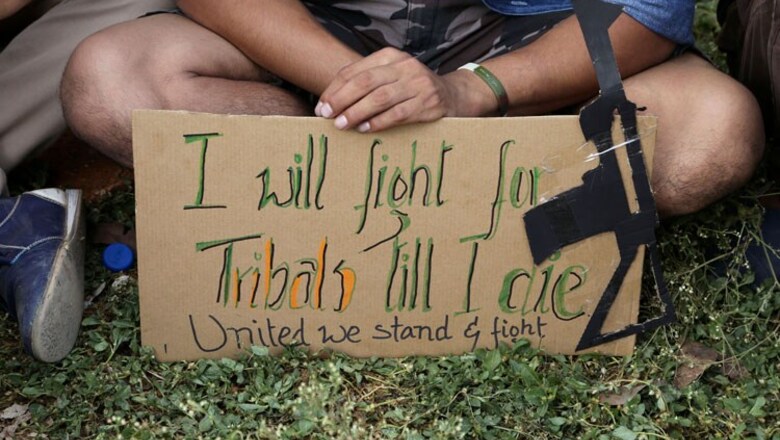
views
"O stranger, thou who passes by, Go, and tell the hills high and low,
That in defending their 'morrow, Here we lie"
- An epithet proposed for the patriots who gave their lives
Barely a month has passed since the smouldering ruins from the burnt houses of tribal legislators of Manipur's southern district kick-started the movement that culminates in the unanimous demand for separate administration of the hills. Without a doubt, this present phenomenon is the most significant event of Manipur hill-valley politics since perhaps the chequered formation of the state itself.
For this movement, which began as a spontaneous outburst against 3 bills unanimously passed in the Manipur legislature, has grown to become much larger than any such thing hitherto; while the goals have been pursued with far greater determination and titanic fibre than ever before. The ongoing movement also differs in important respects from any other highland agitations of the past, the most significant being the unprecedented show of solidarity displayed between and amongst all tribes that have up until this point defined themselves in hatred and opposition to one another. Perhaps the most visible expression of this historic drama is the united front pitched by Kukis and Nagas, the traditional cats-and-dogs of the hills, who now speak as one in the face of this common threat.
Nevertheless many basic questions have persisted unanswered all-too-long. In the midst of so much turmoil and confusion, possibly the only thing one can be truly certain of is that the tribes have had enough of valley despotism; no tribesman wants the oppressive status quo to persist; and they all want political change. No mere cosmetic change but one of a fundamental political nature that which shall affect and benefit the lives of all highlanders hence.
But what type of change? Why, indeed, did it all begin, how? Why did this agitation initially predicted to dive and die like any other before, radically took the most unexpected turns to eventually escalate into a mass movement that it has now become, while showcasing tribal unity at its finest? Who are the leaders of this most important of movements, those who dared to accept the mantle of responsibility when the elected representatives refused representing and betrayed their electors' trust? What are the demands they hope to remould the hills with?
In what follows I shall attempt to outline the story of the struggle, of the fighters who gave that ultimate devotion, and the singular demand that can now be heard ringing throughout these beloved hills.
The Accursed Bills and the Movement
The agitation exploded when Manipur's MLAs passed 3 bills that fated day on 31st August, 2015: the Protection of Manipur Peoples' Bill; Manipur Land Revenue and Land Reforms (Seventh Amendment) Bill; and Manipur Shops and Establishments (Second Amendment) Bill. Why these bills addressing a common theme were partitioned into 3, every tribesman now knows: being deviously concocted in such a way that Manipur's executive body may, with the simple push of a pen, take away by a humdrum gazette the lands of all highlanders whose written ancestry cannot be traced all the way back to 1951.
It must be borne in mind the legislators who tabled and consented to those bills knew very well the forebears of the present tribesmen had already settled in these highlands ages before any pen or paper reached them; and they knew, just as truly, that the overwhelming number of them never kept the records, while even those with records could trace the paper trial to no older than, say, 1972, when Manipur was reconstituted as a state. So we have ancient groups of people living in the hills but possess no records of such habitation except their memories - a perfect recipe ripe for exploitation.
It needs no rocket science to put these two things together. Consequently, for those Meiteis who have for decades coveted the beauteous, sparsely populated lands surrounding that tiny overpopulated patch they call Imphal valley, the most convenient way to legally pilfer them will be to enact a law that requires documentary proof of residence way back to 1951. And thus was born these bills.
Furthermore, while every spokesperson of the state government have ad nauseam claimed the bills have nothing to do with the hills, the tribal wits shoot back with the demand for a separate administration on the ground that this demand has nothing to do with the valley, so even they have nothing to worry! Also, every tribesman and even all the valley folk (with the possible exception of those signatory tribal MLAs) knew that when the bill declared itself applicable to "any part of Manipur", it means any part of Manipur.
Unless of course we are to put their clarification and the bill's statement together to accept that the bills apply to the entirety of Manipur - but because they do not apply to the hills as they also claim, it follows with elegant inevitability the hills are not part of Manipur as such! For if it does not apply to the hills, but the bill applies to any part of the said state, how can the hills be integral to Manipur at all?
Knowing fully well the import of these bills, ATSUM leaders and members had long sought appointments with the tribal legislators to persuade them to oppose the draconian bills before they were even tabled. Not only did the elected representatives refused to meet those they represent; not only did they not gracefully excuse themselves from the assembly by absconding; not only did they not raise a word of protest against the bills when it mattered.These representatives, who were normally absent, dutifully presented themselves before the assembly, gave their due consent by their silence, and came out unmoved, still having the almighty gall not to recant, and to smugly declare to their fellow tribesmen: "the bills do not affect the hills at all!"
For ATSUM and other tribal leaders, that was the stroke that broke the camel's back. Decades of consistent neglect; years and years of untold grievances piling on top of each other, each worse than the last; shattered electoral promises and governance betrayal everywhere; and then this - all these factors combined to inflame their passions long suppressed, and on that bright sunny day that shone through the dreary Lamka clouds, they did the unthinkable by doing the only thing they could still do: protest, and burn down the houses of these neglecting, traitorous lawmakers. 9 brave souls, including a preteen child barely out of his infancy, lost their lives in the mayhem of pent-up anger, craze, arson and unmitigated protests that followed, whose ultimate sacrifices only served to solidify the agitation and turned it, for the first time in this part of the world, into a truly mass movement.
For a time, leaderless arsonists and their uncontrolled fury blackened the scene of protest even as the blood of these diehard souls still flowed in the ground. Fortunately, a taskforce called the Joint Action Committee (JAC) was promptly constituted by agreement of all the tribal bodies, entrusted with the responsibility of piloting and carrying the mission forward.
Through JAC's spirited leadership, the womenfolk, again for the first time in their history, came out in vast numbers to stage sit-in protests in broad daylight (and even under the cover of night), taming on the one hand their hot-headed men ready for any ruckus, and on the other hand, fighting in their own terms for the cause of tribal self-rule. Such protests continued day in and day out, and reached its highpoint on the twilight of September 19, when unprecedented thousands from all tribes from all corners from all dialects came out with flaming torches to throng Lamka Public Ground, and organized the first torch rally in the highland's political history. These same indomitable souls followed up the next day, drenched in the rains, with a handholding protest by forming a human chain 10 miles long, across the entire breadth of Lamka town and its vicinities along the Teddim Road.
In the meantime, representations came from tribal organizations spread throughout Indian cities, even from overseas, submitting to relevant authorities a variety of memorandums, each with a clear, common voice: tribesmen Tribesmen of the hills and Meiteis of the valley can no longer live together under a single polity. In their demand for separate administration that will guarantee self-rule, they ended up petitioning the federal government for one united goal: to make the southern district presently called Churachandpur a Union Territory of India.
But is this demand constitutionally feasible; if feasible, is it practically possible; and if possible, is it politically desirable?
From the perspective of the union government, and from the perspective of the tribesmen demanding the same, I shall affirm in what follows that the demand for a Union Territory is just and feasible.
The Central Case for Union Territory
Union Territories (or UTs in short) are territorial political constitutional units that are indirectly administered by the central government. Their basic structure is provided for in Part VIII of the Constitution, while the provision for the formation of executive, legislative (and even judicial) organs maybe found in Section 3 of the Union Territories' Act. Furthermore, Article 2 & 3 of the Constitution empowers the Parliament with the unilateral authority to change state boundaries and carve out new states and UTs even without the consent of the state(s) concerned (which are of course free to voice their opposition). Therefore, it is clearly within the powers of the Parliament to form a new union territory - should it choose to do so.
But must it choose to do so? Is it practically possible, given the diversity of the tribes living in the southern district presently called Churachandpur, and the concurrent, perhaps overlapping, Naga demand for a separate entity called Nagalim? It is perhaps neither practically possible nor desirable to keep all districts within the same hill administration - I do not know; but as the concern is "Churachandpur", where there is no conflict of interest between Nagas and Non-Naga tribes, I shall address this district alone.
To begin with, it is for the reason of the district's very diversity that it must be metamorphosed into a union territory. Union territories such as Pondicherry and Daman & Diu were carved out precisely because of their distinct history and therefore distinct cultural practices, to ensure these ethno-cultural differences are protected from their mightier and bigger neighbours. Present Churachandpur is also as different from Imphal valley as north India is from the south, with perhaps the only thing they formally share being the name "Churachandpur", which came from a king who once ruled the valley, Churachand Singh. No wonder the district's inhabitants have a catonic hatred of that name - and almost everything else Meitei in origin!
This hatred that has been snowballing for decades now, has at long-last reached its apotheosis. Recent events leave no room for doubt that the hills and valley cannot continue within a common political establishment. Unless a separate administration in the form of a union territory is soon presented forth on the negotiation table as a viable political solution, there is a very real and present danger this ongoing movement will escalate into a hill-valley civil war the like of which the state has never before seen.
Formation of a union territory makes sense not just for the preservation of hill identity, but from the strategic-military perspective. The district of Churachandpurlies 30miles from the international border shared with Myanmar and therefore, has a strategic importance, for which reason the armed forces maybe permanently stationed here.
It must also be borne in mind there is no union territory in the North-East; so a military base here will by extension provide security to the whole of North-East Region. Furthermore, the district is near the border town of Moreh, perhaps the only international commercial hub in the entire NER, even as the planned Trans-Asian highway will cut right through it. It also sits at the crossroads along the routes from Imphal to Aizawl and Imphal to Myanmar's Behiang and therefore, is an important regional and international trading town, whose economic development coupled with armed forces' protection, can alone ensure security and prosperity in the region.
Thus, for strategic and commercial reasons, formation of a union territory is a truly viable and desirable solution even from the perspective of the union government.
The Tribal Case for Union Territory
The ongoing showdown has indubitably demonstrated that tribesmen and the Meiteis must now part ways and live their respective story. But there are dozens of tribes doting Churachandpur district alone, each carving out distinct identities for themselves for over a generation now, and each having separate political demands that are inconsistent with one another. Therefore, even if the tribes were to be given a separate political entity, so the argument goes, they will tear themselves apart.
Keeping aside the patronizing tone of this argument that implies the tribes cannot govern themselves, it has many other holes. For one, all the tribes of Churachandpur district are non-Naga tribes belonging to the Kuki-Zomi-Chin fold. Meaning that they share a common heritage, unified cultural practices and patterns, and all their tongues spring forth from the same mother language. The differences amongst the tribes are only those of minutiae and not of substance, and ultimately boil down to one: linguism. But even this is a surmountable barrier: all these variegated non-Naga tribes virtually understand what the other says as their dialects are not so differentiated yet to become distinct languages on their own. The rites and rituals, customs and practices, are more or less similar, differing only in insignificant details much as the culture of Delhi University's south campus may differ from the north campus. Were it not for the problem of nomenclature, the disappearance of these disputes is virtually a foregone conclusion.
So why do the tribes now fight amongst themselves? As of now they do not - they are now standing as one in the demand for separate administration, forgetting their petty differences and coming together in a common brotherhood. However, the internecine conflicts that defined their recent past owe itself to the divide-and-rule game the Meiteis had been playing since the formation of the statehood, by following a carrot-and-stick policy to reward those willing to bend their knees and to punish the rest. Take away the Meiteis, and there will be none to divide their common rule, as the tribes will now govern themselves rather than be governed by others. Gone will be the squabbling for the crumbs once their cake is returned to them.
Also, a union territory is desirable as the region is too small to be a state, though too distinct to be uncomfortably enmeshed with the valley. But such a union territory, within the constitutional boundaries, must provide a room for the formation of an executive branch wherein the Council of Ministers will advise the lieutenant-governor; and there must be a legislative body to whom the ministerial cabinet will be collectively accountable, wherein also the tribesmen can determine for themselves which laws to follow. The union territory must therefore be designed along the lines of the NCR of Delhi, or of Pondicherry, as in any case no government can be justified in a democratic polity that is not formed by the consent of the governed.
The advantages of forming a union territory may be listed in bullet points as follows:
- Central development funds will directly cater to the region rather than be first filtered off in Imphal (meaning that a substantive improvement will be seen in the quality of infrastructural projects undertaken);
- New jobs in their thousands will be thrown open in all sectors both governmental and otherwise;
- elections may now be freely and fairly held as the people need choose only amongst themselves, and truly representative leaders accountable to their electors will hold the political offices;
- The region shall be under the direct protection of the union government;
- its strategic location maybe capitalized upon for trading purposes to make it a truly commercial cosmopolitan hub, with especial expertise in the service sectors, as the level of education in Churachandpur, both in quality and quantity, and the glorious diversity of its populace, surpass its environs.
Separate administration in terms of a union territory is therefore the only way forward for the peace and tranquility of the region as a whole, and development of the hills along highland lines.
The French Revolution began in 1789 with the storming of Bastille, shook the foundations of their world, overturned the ancient regime and created a new reality fundamentally different from what went before. Would the conflagration of the legislators' houses be the Bastille of the hills; or will it merely be a mirage that burns out with the flames? Will the tribes continue their united fight for the common cause, burying their trivial differences - or return to the old, tragic game of warring against one another on the most inconsequential matters? Will the movement for greater autonomy end in the formation of a union territory; or it be another in a series of meaningless agitations that began with a bang to only end in whimpers, drowning in the silence of the distant dark?
Only time will tell. For the moment, let us wait and watch the making of history, and light the candles of hope again.
PS: The demand for separate administration must be seen as a long-term solution, of which the necessary first steps maybe taken now. The short-term goals of squashing the bills, conduct of independent judicial enquiry on the killings, recognition for the dead, etc, maybe demanded for now as a show of good faith to the tribesmen and as precondition for any negotiation.
(Disclaimer: The author Min Khooptong is a legal transcriber based in New Delhi. The views expressed are of the author and do not reflect the stand of CNN-IBN/ IBNLive)




















Comments
0 comment